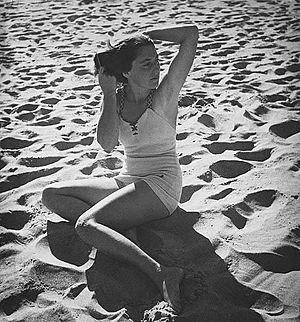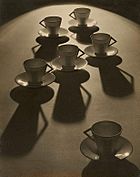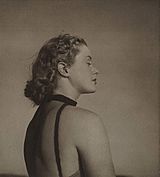Olive Cotton facts for kids
Quick facts for kids
Olive Cotton
|
|
|---|---|

Cotton at the beach, taken by Max Dupain circa 1930s
|
|
| Born |
Olive Edith Cotton
11 July 1911 Sydney, New South Wales, Australia
|
| Died | 27 September 2003 (aged 92) Cowra, New South Wales, Australia
|
| Nationality | Australian |
| Education | University of Sydney |
| Known for | Photography |
| Spouse(s) |
Max Dupain
(m. 1939–1944)Ross McInerney (m. 1944- her death) |
Olive Cotton (11 July 1911 – 27 September 2003) was a very important Australian photographer. She was known for her modern style in the 1930s and 1940s. Olive Cotton became famous across Australia much later, in 1985, when her photos were shown in a special exhibition. A book about her life and work was published in 1995. She often photographed her childhood friend and first husband, Max Dupain, especially when he was working.
Contents
Early Life
Olive Edith Cotton was born on 11 July 1911. She was the oldest of five children in a creative and smart family. Her parents, Leo and Florence, loved music and were interested in social issues. Her mother was a painter and played the piano. Her father, Leo, was a geologist who took photos on an expedition to the Antarctic in 1907. The Cotton family lived in a bushy area of Sydney called Hornsby.
When Olive was 11, she received a Kodak Box Brownie camera. With her father's help, she turned their home laundry room into a darkroom. This is where she developed her first black and white photos. In 1924, while on holiday at Newport Beach, she met Max Dupain. They became good friends because they both loved photography. One of her early photos, "She-oaks" (1928), was taken around this time.
Olive went to the Methodist Ladies' College in Sydney from 1921 to 1929. She won a scholarship and then studied English and Mathematics at the University of Sydney. She also loved music and was a talented piano player.
Photography
Olive Cotton joined photography groups like The Sydney Camera Circle. Here, she learned a lot from famous photographers such as Harold Cazneaux.
She showed her first photo, "Dusk," in an exhibition in 1932. Other photographers and models, like Damien Parer and Jean Lorraine, often visited the studio where she worked.
In Australia during the 1930s, most people expected a man to be the main photographer. Olive often called herself "the assistant." But whenever she could, she took photos of famous visitors or interesting things in the studio. She even captured Max Dupain working in her photo, "Fashion shot, Cronulla Sandhills, circa 1937." A publisher named Sydney Ure Smith gave her many jobs. He thought she was one of the best photographers of her time.
The Commonwealth Bank's staff magazine, Bank Notes, also used Olive's non-commercial photos as illustrations.
Style
In the 1930s, Olive became very skilled at the "Pictorial" style of photography, which was popular then. She also used a very modern approach. Her photos felt personal and showed her love for how light played on things around her. From 1934 to 1940, she worked as Max Dupain’s assistant in his studio in Sydney. There, she developed her own unique way of taking pictures. She focused on how light looked on everyday objects and in nature. She often used her Rolleiflex camera to capture people's natural reactions while Max set up lights for a portrait. Her style quickly became different from other modern photographers.
Signature Photographs
Tea cup ballet (1935) is one of Olive's most famous photos. She took it in the studio after buying some cheap cups from Woolworth's. She used a special lighting trick, shining light from behind the cups. This made strong shadows that looked like dancing shapes. The photo was shown in London in 1935. It became her most recognized image and was even put on a stamp in 1991. Tea cup ballet is also on the cover of the book Olive Cotton: Photographer.
Other important photos include Shasta Daisies (1937) and The Budapest String Quartet (around 1937). These were shown in an exhibition in 1937.
In 1945, Olive got many jobs, including taking photos of flowers for a book called Flowerpieces. Sydney Ure Smith continued to support her work, and she did many projects for his art magazines.
Later Career
In 1947, Olive Cotton moved to Cowra, New South Wales, with her family. From 1959 to 1964, she taught Mathematics at Cowra High School. Then, she opened a small photography studio in Cowra. She took many portraits and wedding photos for people in the area. Her work became very popular there, even though she was not yet well-known in the city art world until 1985.
Personal Life
In 1939, Olive married her long-time friend, Max Dupain. They separated in 1941 and divorced in 1944.
In 1947, Olive moved to a rural area about 35 kilometers from Cowra, New South Wales. She moved there with her new husband, Ross McInerney. They lived in a tent for three years before moving to a small farm. Their two children grew up there.
Death
Olive Cotton passed away on 27 September 2003, at the age of 92.
Legacy
The special Olive Cotton Award for Photographic Portraiture was created to honor her. It is funded by Cotton's family and held at the Tweed Regional Gallery in New South Wales.
Exhibitions
Olive Cotton's work was shown in many exhibitions, including:
- 1935 London Salon of Photography, London, UK
- 1937 Victorian Salon of Photography
- 1938 Commemorative Salon of Photography exhibition by the Photographic Society of NSW
- 1938 Group show with the Contemporary Camera Groupe at David Jones Gallery, Sydney
- 1945 First International Adelaide exhibition
- 1946 through 1989: Exhibitions with Creative Vision, Sydney, NSW
- 1981 Australian Women Photographers 1890-1950 touring exhibition
- 1985 Olive Cotton Photographs 1924-1984 special exhibition at the Australian Centre for Photography, Sydney, which then toured many galleries
- 1992 Solo exhibition Olive Cotton, Australian Girls Own Gallery, Canberra, ACT
- 1995 Women Hold Up Half The Sky, National Gallery of Australia, Canberra, ACT
- 1995 In a Certain Light: Clarice Beckett and Olive Cotton, Ivan Dougherty Gallery, Paddington, NSW
- 1995 Women and Art, Mary Place Gallery, Paddington, NSW
- 1995 Beyond the Picket Fence: Australian Women's Art in the National Library Collections, National Library of Australia, Canberra, ACT
- 1996 The Reflecting Eye: Portraits of Australian Visual Artists, National Portrait Gallery, Canberra, ACT
- 1997 The Studio of Max Dupain, State Library of NSW
- 2000 Solo exhibition Olive Cotton Retrospective, Art Gallery of NSW, Sydney
- 2002 Solo exhibition Cotton Tales of family photographs
- 2007 What's in a Face? Aspects of Portrait Photography, Art Gallery of NSW, Sydney
- 2013 Flatlands: Photography and Everyday Space, Art Gallery of NSW, Sydney.
- 2015 The Photograph and Australia, Art Gallery of NSW, Sydney
Collections
Olive Cotton's photographs are held in many important collections, such as:
- National Gallery of Australia, Canberra
- Art Gallery of New South Wales, Sydney
- State Library of New South Wales
- Camping trips on Culburra Beach, N.S.W., 1937
- Photographs taken for Greta Lofberg, December 1938
- Cherry blossom, ca. 1946, photographed by Olive Cotton
- Shots of flowers, poppies, ca. 1946, photographed by Olive Cotton
- Interview with Olive Cotton, 19 July 1997
- National Gallery of Victoria, Melbourne
- Waverley City Council Collection, Melbourne
- Horsham Regional Art Gallery, Victoria



